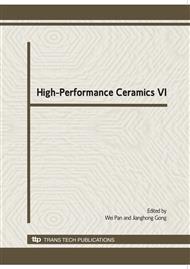p.469
p.474
p.477
p.481
p.485
p.489
p.492
p.496
p.499
In Situ-Fabrication of TiCN Ceramic Coating on Titanium Alloy by Laser Cladding Technology
Abstract:
The insitu-fabrication of TiCN ceramic coating by laser cladding-laser nitriding technique (LC-LN) was investigated. Pulsed YAG laser with the power of 500W was used as radiation source. Highly pure N2 was selected as the nitriding element; Titanium powder whose size is 20 m and the pure carbon powder were utilized as the coating materials. The influence of technology parameters such as pulse width, pulse frequency and scanning speed etc. on the insitu-formation of TiCN ceramic coating was studied. XRD results show that the main phases of the coating are TiC0.3N0.7 (or TiC0.2N0.8),TiN and TiN0.3. It was revealed that the appropriate process parameters for insitu-fabrication are the pulse frequency 15 Hz, pulse width 3.0ms, the scanning speed in the range of 9cm/min to 12cm/min, the pressure of N2 0.4MPa. The result of OM showed a metallurgical bonding without crack and bubble between the coating and the substrate was obtained. The microstructure of cladded coating is characterized by fine dentrites. The average microhardness in the coating is more than 1300HV which is about 4 times of that in the substrate.
Info:
Periodical:
Pages:
485-488
Citation:
Online since:
March 2010
Authors:
Keywords:
Price:
Сopyright:
© 2010 Trans Tech Publications Ltd. All Rights Reserved
Share:
Citation:


